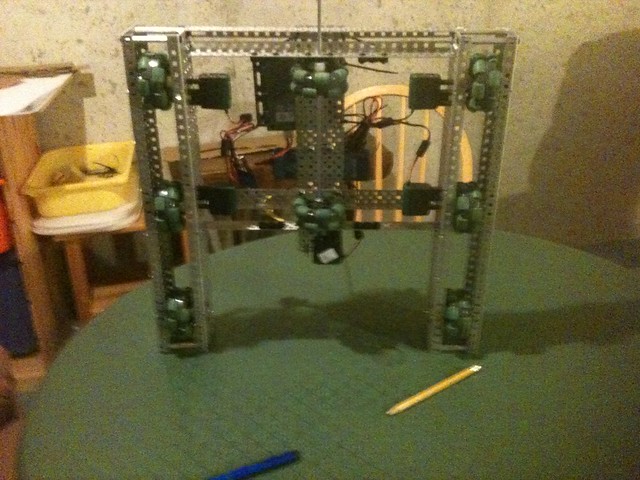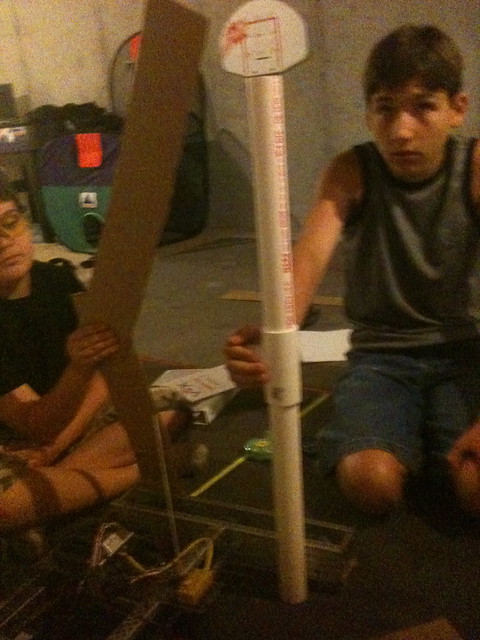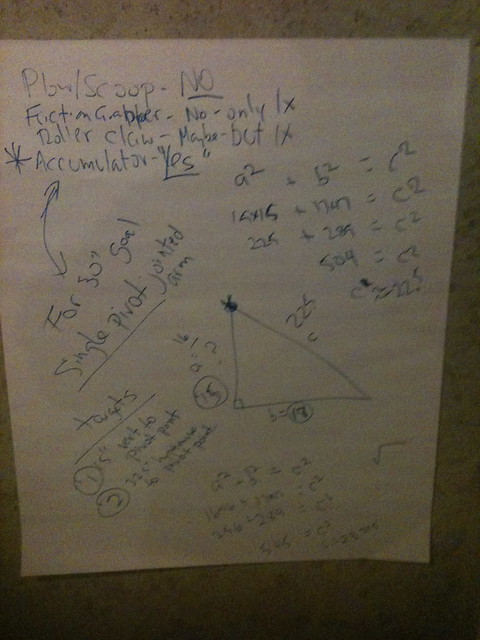Monday, July 25, 2011
That darned third dimension... July 18, 21, 26, 29 meetings
Sorry...not much blogging time lately. Last two weeks were dedicated to some driver practice and working on the arm and accumulator. Progress is slow and steady and that darned third dimension up and bit us as we couldn't quite fit our intended arm hypotenuse length into the 18"x18"x18" starting configuration. Since our arm lengths have depth to them to house our forthcoming accumulator we wound up shortening the hypotenuse a few inches. "Fit testing" after showed, however, that we would still be able to reach the 30" goal as intended. After that, on the 26th and 29th we continued fleshing out the accumulator, getting it all to fit, getting intake tread mounted, etc. Slow work indeed, but progress non the less. More details, photos, etc coming soon.
Wednesday, July 13, 2011
multi-tasking, with purpose ... July 12 meeting...
In my eleven years of student robotics competition experience, I've seen many, many teams make the same unrecoverable mistake over and over - working like crazy on the robot until the last minute before an event without spending much time practicing to play the competitive game well. The result of getting too geeked out on the technology like this nearly always results in a robot and a team that underachieves in competition. I'm determined not to let that happen to the Robobraves in our rookie VRC season. So, armed with that idea, along with our fully functional drivetrain and a clear plan for iteration 1.0 of a single-jointed arm accumulator that reaches all goal heights (see previous blog entries for details), we began dividing and conquering at Tuesday's meeting.
Half of the team, with clear instructions, began driver practice with the drivetrain while the other half set to work on the arm hypotenuse. Half way through the meeting, the groups switched giving all present team members some experience measuring, cutting, filing, assembling, and applying corresponding safety procedures as well as simulating what play might me like in the Gateway interaction zone in a two-minute time period - moving toward goals, avoiding an opponent robot, delivering game objects and taking clear instructions from an on-field coach.
During both activities, professionalism was stressed - measuring carefully, cutting straight, not over filing, knowing the value of keeping everything straight and square, using the safety glasses as necessary, moving as efficiently as possible with the drivetrain while simulating game conditions, getting to know how to slide, spin, and turn the robot to take full advantage of the drivetrain attributes this robot possesses.
We've got a long way to go, but by meeting's end the team had a better sense of the drivetrain, playing in the interaction zone, operating from the player station, thinking about efficient and effective movements as well as having improved just a little with our manufacturing and assembly skills.
On the surface, it looked like not much happened at today's meeting, but in reality, this was really our most important step thus far. Look for all meetings from here forward to include some kind of driver practice as the relationship between man and machine both off and on the field of play is critical to team success.
Meeting photos, here and as always, learn more about our parent organization, Upper Perk Robotics at uprobotics.org
-Kressly
Half of the team, with clear instructions, began driver practice with the drivetrain while the other half set to work on the arm hypotenuse. Half way through the meeting, the groups switched giving all present team members some experience measuring, cutting, filing, assembling, and applying corresponding safety procedures as well as simulating what play might me like in the Gateway interaction zone in a two-minute time period - moving toward goals, avoiding an opponent robot, delivering game objects and taking clear instructions from an on-field coach.
During both activities, professionalism was stressed - measuring carefully, cutting straight, not over filing, knowing the value of keeping everything straight and square, using the safety glasses as necessary, moving as efficiently as possible with the drivetrain while simulating game conditions, getting to know how to slide, spin, and turn the robot to take full advantage of the drivetrain attributes this robot possesses.
We've got a long way to go, but by meeting's end the team had a better sense of the drivetrain, playing in the interaction zone, operating from the player station, thinking about efficient and effective movements as well as having improved just a little with our manufacturing and assembly skills.
On the surface, it looked like not much happened at today's meeting, but in reality, this was really our most important step thus far. Look for all meetings from here forward to include some kind of driver practice as the relationship between man and machine both off and on the field of play is critical to team success.
Meeting photos, here and as always, learn more about our parent organization, Upper Perk Robotics at uprobotics.org
-Kressly
Friday, July 8, 2011
iterations and calculations ... 7/5 and 7/8 meetings
The 7/5 meeting time was eaten up with drivetrain iterations. We were unhappy with the fact out two stacked center/sideways wheels weren't always contacting the field tiles. However, the field tiles were laid on top of overlapping carpet remnants, thus the first order of business was to yank/roll up the offending carpet and lay the field tiles flat on the floor so we could retest the drivetrain to see it we "really" had an issue. Sure enough, the sideways wheels still weren't performing as desired because...
b. my basement floor isn't totally levelWe retested one more time, taking closer looks at everythnig and concluded that both a AND b were the culprits. However, we also concluded, that ANY floor we compete out could be less than level, so after flushing the rails we also went through three more iterations of the center/sideways wheel layout. v1.1 we split the wheels across the horizontal of the drivetrain using three gears and the same single motor. Results were somewhere between "no change" and "worse." v1.2 we went back to the stacked single shaft for both of these wheels, spreading a greater front to back distance between the two center sideways wheels. We liked these results but felt we could do even better with a longer spread between the two rails, thus we landed on v1.3 (as seen below) which, by far, tested the best! We'll keep it this way to practice and only tweak if performance worsens with wheel wear and addition of object manipulator(s).

So, with those additional (and much needed) drivetrain iterations, we were out of time to begin manipulator discussions an calculations. Thus, our July 8 meeting held three agenda items:
1. Trim shaft to size for for v1.3 of our drivetrain
2. Use Pythagorean Theorem and cardboard lengths to plan for a single jointed arm with the lowest possible pivot point (to keep COG down) that could reach well over the 30" goal (33" to 34" should give use the clearance we desire).
3. Learn about the basic types of robotic object manipulators and decide what our best option would be.
We got right to business as the first two Robograves arrived and too care of item 1 in short order. All attending also learned a little about cutting and filing efficiently and safely. For item 2 we assembled with notebooks, calculators, our theorem, cardboard strips of varied lengths we cut last time, and a loose piece of shaft. After reviewing the theorem, doing a few iterations of math in notebooks and on our chart paper, then testing it out with our cardboard and shaft, we were able to set our target arm distances of 15" vertically from the floor to the pivot point and approximately 22.5" from tip of manipulator to the pivot point (hypotenuse of the triangle). Here's part of the process:

To complete item 3 on the agenda, we reviewed definitions and examples of different types of robotic object manipulators, then applied the knowledge to the Gateway game and our agreed upon manipulator priorities to conclude our most desired manipulator was an accumulator of some kind. So all together we can safely say, we now would optimally like a single jointed arm that elevated and lowers an accumulator.

So, we concluded our meeting researching internet video of past VEX competitions that had single jointed arm accumulators to get ideas. We learned a lot by doing this including Bryan's revelation of, "It's best to look for finals matches at events because they are the best robots ... and they are almost ALL accumulators!" This was excellent validation for a team that hasn't "been there" or "done that" ... yet!
With our agenda items taken care of there was even time left for our two video research groups to sketch some ideas for what our arm/manipulator might look like and make very detailed engineering notebook entries for the day.
I like the way our team is starting to come together and looking forward to beginning our manipulator build.
Until next time,
Kressly
Subscribe to:
Posts (Atom)